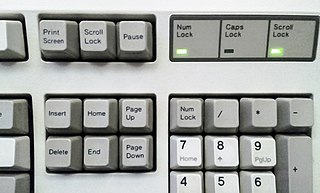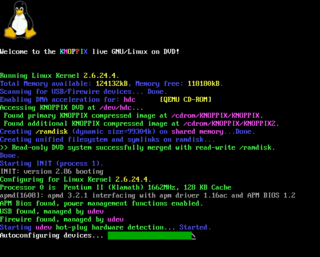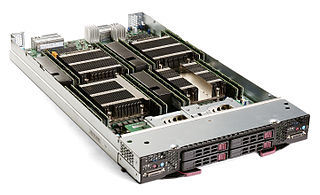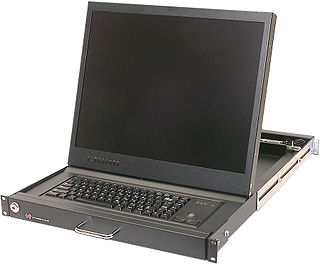Related Research Articles

The technology of computer keyboards includes many elements. Among the more important of these is the switch technology that they use. Computer alphanumeric keyboards typically have 80 to 110 durable switches, generally one for each key. The choice of switch technology affects key response and pre-travel. Virtual keyboards on touch screens have no physical switches and provide audio and haptic feedback instead. Some newer keyboard models use hybrids of various technologies to achieve greater cost savings or better ergonomics.

Scroll Lock is a lock key on most IBM-compatible computer keyboards.

A 19-inch rack is a standardized frame or enclosure for mounting multiple electronic equipment modules. Each module has a front panel that is 19 inches (482.6 mm) wide. The 19 inch dimension includes the edges or "ears" that protrude from each side of the equipment, allowing the module to be fastened to the rack frame with screws or bolts. Common uses include computer servers, telecommunications equipment and networking hardware, audiovisual production gear, music production equipment, and scientific equipment.
Apollo/Domain was a range of workstations developed and produced by Apollo Computer from circa 1980 to 1989. The machines were built around the Motorola 68k family of processors, except for the DN10000, which had from one to four of Apollo's RISC processors, named PRISM.

System x is a line of x86 servers produced by IBM, and later by Lenovo, as a sub-brand of IBM's System brand, alongside IBM Power Systems, IBM System z and IBM System Storage. In addition, IBM System x was the main component of the IBM System Cluster 1350 solution.

One meaning of system console, computer console, root console, operator's console, or simply console is the text entry and display device for system administration messages, particularly those from the BIOS or boot loader, the kernel, from the init system and from the system logger. It is a physical device consisting of a keyboard and a screen, and traditionally is a text terminal, but may also be a graphical terminal. System consoles are generalized to computer terminals, which are abstracted respectively by virtual consoles and terminal emulators. Today communication with system consoles is generally done abstractly, via the standard streams, but there may be system-specific interfaces, for example those used by the system kernel.

A blade server is a stripped-down server computer with a modular design optimized to minimize the use of physical space and energy. Blade servers have many components removed to save space, minimize power consumption and other considerations, while still having all the functional components to be considered a computer. Unlike a rack-mount server, a blade server fits inside a blade enclosure, which can hold multiple blade servers, providing services such as power, cooling, networking, various interconnects and management. Together, blades and the blade enclosure form a blade system, which may itself be rack-mounted. Different blade providers have differing principles regarding what to include in the blade itself, and in the blade system as a whole.

A KVM switch is a hardware device that allows a user to control multiple computers from one or more sets of keyboards, video monitors, and mice.
Multiplicity is a computer program that enables one keyboard and mouse to access two or more client computers from a host computer. It was developed for Stardock as part of their ThinkDesk subscription service, but is available separately.
The IBM Remote Supervisor Adapter is a full-length ISA or PCI adapter produced by the IBM corporation.

Avocent, a business of Vertiv, is an information-technology products manufacturer headquartered in Huntsville, Alabama. Avocent formed in 2000 from the merger of the world's two largest manufacturers of KVM equipment: Apex and Cybex Computer Products Corporation. As of August 2006, the company employed more than 1,800 people worldwide.

In broadcast facilities and television studios, a central apparatus room, central machine room, or central equipment room (CER), or central technical area (CTA), or rack room is where shared equipment common to all technical areas is located. Some broadcast facilities have several of these rooms. It should be air-conditioned, however low-noise specifications such as acoustical treatments are optional. Equipment is connected either directly with an attached foldout monitor, keyboard and mouse or remotely via KVM switch, SSH, VNC, RS-232 or remote desktop.
A headless computer is a computer system or device that has been configured to operate without a monitor, keyboard, and mouse. A headless system is typically controlled over a network connection, although some headless system devices require a serial connection to be made over RS-232 for administration of the device. Headless operation of a server is typically employed to reduce operating costs.

The Dell blade server products are built around their M1000e enclosure that can hold their server blades, an embedded EqualLogic iSCSI storage area network and I/O modules including Ethernet, Fibre Channel and InfiniBand switches.
The ThinkServer product line began with the TS100 from Lenovo. The server was developed under agreement with IBM, by which Lenovo would produce single-socket and dual-socket servers based on IBM's xSeries technology. An additional feature of the server design was a support package aimed at small businesses. The focus of this support package was to provide small businesses with software tools to ease the process of server management and reduce dependence on IT support. The tools developed for this support package included:
Dell PowerEdge VRTX is a computer hardware product line from Dell. It is a mini-blade chassis with built-in storage system. The VRTX comes in two models: a 19" rack version that is 5 rack units high or as a stand-alone tower system.

A KVM is a computer input/output device offering the combination of a keyboard, video monitor and mouse. They are typically constructed to fit into a 19-inch rack although there are manufacturers who offer a KVM that can be mounted to a flat surface such as a control console.

ATEN International Co.(Ltd) is a Taiwanese multinational manufacturer of connectivity and access management hardware headquartered in Xizhi District, New Taipei, Taiwan. Its products include KVM switches, audiovisual switches and matrices, intelligent power distribution units, information technology management systems, and interface adapters. ATEN has subsidiaries in several countries and is the parent company of IOGEAR.

The IBM DS8000 series is an IBM storage media platform with hybrid flash and hard disk storage for IBM mainframes and other enterprise grade computing environments.
References
- ↑ Hoskins, Wilson, Winkel, "Exploring IBM @Server Series", CT2 Interconnect Cable Chaining Technology - Google Books